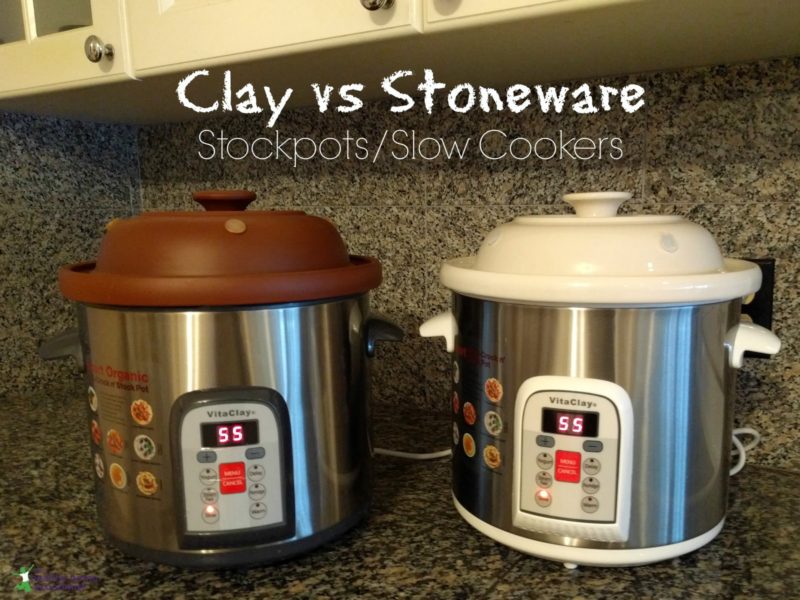Table of Contents[Hide][Show]

There is no doubt in my mind that bone broth you make yourself is nutritionally superior to commercial brands. If you still aren’t sure, try this easy test. Buy any of the popular brands and put a container in the refrigerator. Notice how it remains liquid and doesn’t transform into a familiar gelatinous blob like a mason jar full of homemade bone broth. Add to this the risks from toxic packaging (unless in glass), and there isn’t any contest. Broth made at home wins hands-down.
After realizing that a weekly pot of bone broth is one of the most important (and simple) tasks for keeping your family (and yourself!) healthy, the next question is this … what type of stockpot is best?
While stainless steel stockpots, crockpots or pressure cookers like Instapot might seem to be a good idea, it is really best to steer clear. The safest bone broth is actually made in clay or enamel pots (lead-free and tested for purity of course).
These materials are superior due to the high risk of carcinogenic nickel and excessive chromium leeching from the stainless steel during cooking. The dangers are particularly acute for long simmering bone broth, which is slightly acidic from the addition of small amounts of vinegar. Even quick cooking meat stock simmers for an hour or two. Now don’t worry that you need to replace all your stainless steel cookware! The risk is primarily from cooking acidic foods, not other types of dishes!
VitaClay Stockpots
These concerns led me to switch to a VitaClay stockpot/slow cooker a few years ago once I dug into the alarming research of cooking acidic foods in stainless steel.
If you make a lot of bone broth at home like I do and want to make the switch too, the next question is … what type of stockpot is optimal. Glazed stoneware or clay?
As you can see from the picture above, I have both types of stockpots on my kitchen counter. I’ve been comparing the two to try and help answer this question for myself.
Let me share what I’ve learned so it can perhaps help you sort through the options as well.
Clay Stockpot vs Stoneware Stockpots
When comparing a clay stockpot vs a stoneware stockpot from a functional standpoint, there is little difference.
Similarities
Both models accomplish all of the following very well:
- Cook in about half the time of a crockpot.
- Delayed timer so that you can soak oatmeal AND cook in one step instead of two.
- Energy saver green appliance using up to 60% less energy.
- Rice cooker (soaks AND cooks in one step using the delay timer feature).
- Makes both regular and Greek yogurt.
- Easy clean-up.
- Nontoxic, lead-free and tested for purity.
- Attractive on the kitchen counter.
Differences
From a practical and aesthetic standpoint, here are the few differences I’ve noted.
- The clay stockpot is more fragile than the stoneware. Although I’ve had no problems with chipping, cracking, or breakage in the years I’ve used one, I can see where some people might experience problems. Stone is inherently more durable than clay. The good news is that Vitaclay does offer replacement pots if necessary if you prefer the clay model.
- The stoneware stockpot simply because it doesn’t require topping up with water. Stoneware doesn’t breathe like clay does, hence the broth doesn’t simmer down as quickly. On the other hand, if you like to make homemade bouillon cubes, reduction sauces, or homemade sweetened condensed milk, the clay stockpot would be a better choice.
- If you plan to keep the stockpot on your kitchen counter, the clay or the stoneware model might look better depending on your color scheme. My kitchen is black and white so the stoneware model is more striking.
- Slow-cooked food tastes a bit better cooked in the clay stockpot/slow cooker. This is due to the breathability of the clay. My husband doesn’t really notice a difference in taste between the two, but I think the clay model produces tastier results.
Which is Best?
In conclusion, it is ultimately up to you to decide which Vitaclay bone broth/slow cooker is best based on your intended usage pattern. The similarities and differences itemized above can hopefully prove helpful to your decision!
By the way, if you intend to try one of these wonderful appliances for yourself, use coupon code WISE25 to get 10% off the model of your choice.








Hi Sarah Did you have an article on which insta pot to buy? I thought I read your recommendation a few weeks ago. My daughter is vegetarian and will not be using it for bone broth. I am a big fan of your articles!
Do you have a recommendation re a safe bread maker? Can you bake bread in a Vita Clay? I do not want to use a bread maker that has a Teflon or other non-healthy interior. Thank you in advance for your response.
You cannot bake bread in a Vita-Clay. I don’t use a breadmaker, so cannot recommend one. I bake in glass bread pans in the oven.
Do you have a recommendation for a bread dish (don’t want to use a bread maker), for baking bread? I’ve seen glass bread dishes. I’ve also seen clay/stone bread dishes, but unsure of whether or not they are made from safe material(s). VitaClay does not mention anything (that I’ve seen) about baking bread in their cookware. I would prefer above all else to find mini clay/stone/glass baking dishes for bread, since I have a small household. Thank you in advance for your input.
Hi Sarah
I love my vitaclay, I got one a few months ago thanks to your recommendation. I have the clay one pictured. In the instruction booklet I received it specifically says not to cook rice in this model so I haven’t tried. Would you mind confirming if you have cooked rice in this version of the vitaclay? I have seen you have other versions and wondered if you had specifically cooked rice successfully in the vitaclay pictured.
Thanks so much!
Madeleine
So glad you like it! I use the larger Vita-Clay for making broth. I use the smaller model to make rice although the larger one will make steamed rice as well 🙂
I would also like to know how many quarts the Vita-Clay actually holds. I have seen both 5 and 4.5 quarts by reviewers compared to the advertised 6 quarts. I would like to know whether the Vita-Clay can be used as a replacement for a slow cooker because I do not plan to primarily use it for broth or gelatin.
It says 4.5 L on the inside of my pot. It think the confusion might be the difference between what it holds in volume vs weight.
Does the stoneware pot really hold 6.5 quarts? A reviewer on Amazon said it only held 5.
So great in so many ways – including a sense of humor !! A leg-hugging drooling robot – Love It !!!!
Hi Sarah – I just got my VitaClay Stoneware pot, per the recommendation of your research! (I’ve been making my own chicken bone broth for a long time, in a stainless steel stock pot, heating to a barely bubbling for 2-3 days. I get a deep, rich broth.) I’m confused as to what settings to use on the VitaClay: on page 6 it says for Bone Broth SLOW cook for “5-8 hours then WARM for 10 hours**.” On page 14 it says chicken takes 2 hours, then WARM for 2-12 hours. I found that SLOW produces a too rapid boil and WARM produced hot but not boiling. Can I not get the barely boiling? If not, will I get the gelatin I’m aiming for? How do I get the super long cook for the dark, rich broth I’m used to? Thanks!
I get tons of gelatin and a nice dark broth with mine, so no worries there if you use the proper ratio of meaty bones to boney bones (about 50-50). If you are getting too high of a simmer, then you can alternate a few hours on slow and then an hour or so on warm and back and forth for the minimum of 6 hours.
VitaClay® Chef (VitaClay® Chef)
Dec 19, 18:01 PST
Hello,
Yes! Definitely, the inner pots are interchangeable – the housings are the same.
Let me know if you have any other questions!
Here’s to your health,
Andy
Vitaclay customer service
What about Corning ware?
I haven’t seen a corningware stockpot but that would be fine if you’ve found one somewhere.